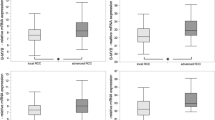Abstract
Purpose
Renal oncocytomas are assigned as benign tumours, and their detailed molecular mechanism is poorly characterised. Activation of the PKB/Akt pathway is assumed to contribute to the pathogenesis and progression of malignant disease. For oncocytomas, hardly any data are available for Akt signalling parameters. Aim of the present work was to determine the alterations of Akt parameters PTEN, phosphorylated Akt (p-Akt) and p27Kip1 in oncocytoma to better understand the dedifferentiation of renal tumours.
Methods
By tissue microarray analysis 15 oncocytoma, 18 clear cell renal cell carcinoma (ccRCC) and the corresponding benign tissue were investigated. Significant expression differences between PTEN, p-Akt and p27Kip1 were determined by immunohistochemistry using One-way ANOVA with all pairs Tukey–Kramer as post hoc analyses. To investigate Akt parameter interactions in the oncocytoma, linear regression analyses were performed.
Results
Expression of all proteins was significantly different between the groups and in all groups the lowest for oncocytoma: PTEN: 32.9 ± 13.0 versus 75.5 ± 8.0 versus 123.7 ± 8.8; p < 0.001 for oncocytoma, benign parenchyma and ccRCC and 2.7 ± 1.2 versus 40.8 ± 9.5 versus 143.6 ± 12.2; p < 0.001 for p27Kip1. p-Akt expression was significantly different between oncocytoma and ccRCC (67.3 ± 15.7 vs. 144.0 ± 26.6; p < 0.05).
Conclusion
All three investigated parameters were the lowest in oncocytoma when compared to ccRCC. Expression of PTEN and p27Kip1 seems to be exceedingly associated with malignant conditions of ccRCC. These findings might contribute to the understanding of tumorous signalling of the PKB/Akt axis in renal tumours.



Similar content being viewed by others
References
Romis L et al (2004) Frequency, clinical presentation and evolution of renal oncocytomas: multicentric experience from a European database. Eur Urol 45:53–57 (discussion 57)
Eble JN (2004) Tumors at the kidney, chap 1. In: Eble JN, Sauter G, Epstein JI (eds) Pathology and genetics of tumours of the urinary system and male genital organs. World Health Organisation classification of tumours. IARC Press, Lyons, pp 9–88
Van der Kwast T, Perez-Ordonez B (2007) Renal oncocytoma, yet another tumour that does not fit in the dualistic benign/malignant paradigm? J Clin Pathol 60:585–586
Gudbjartsson T et al (2005) Renal oncocytoma: a clinicopathological analysis of 45 consecutive cases. BJU Int 96:1275–1279
Cheng L et al (2009) Molecular and cytogenetic insights into the pathogenesis, classification, differential diagnosis, and prognosis of renal epithelial neoplasms. Hum Pathol 40:10–29
Cossu-Rocca P et al (2008) Interphase cytogenetic analysis with centromeric probes for chromosomes 1, 2, 6, 10, and 17 in 11 tumors from a patient with bilateral renal oncocytosis. Mod Pathol 21:498–504
Fuzesi L et al (1994) Renal oncocytoma with a translocation t(9;11) (p23;q13). J Urol 152:471–472
Rohan S et al (2006) Gene expression profiling separates chromophobe renal cell carcinoma from oncocytoma and identifies vesicular transport and cell junction proteins as differentially expressed genes. Clin Cancer Res 12:6937–6945
Escudier B et al (2007) Sorafenib in advanced clear-cell renal-cell carcinoma. N Engl J Med 356:125–134
Motzer RJ et al (2007) Sunitinib versus interferon alfa in metastatic renal-cell carcinoma. N Engl J Med 356:115–124
Song G, Ouyang G, Bao S (2005) The activation of Akt/PKB signaling pathway and cell survival. J Cell Mol Med 9:59–71
Altomare DA, Testa JR (2005) Perturbations of the AKT signaling pathway in human cancer. Oncogene 24:7455–7464
Samuels Y, Ericson K (2006) Oncogenic PI3 K and its role in cancer. Curr Opin Oncol 18:77–82
Brenner W et al (2002) Loss of tumor suppressor protein PTEN during renal carcinogenesis. Int J Cancer 99:53–57
Fuhrman SA, Lasky LC, Limas C (1982) Prognostic significance of morphologic parameters in renal cell carcinoma. Am J Surg Pathol 6:655–663
Merseburger AS et al (2006) Activation of the PKB/Akt pathway in histological benign prostatic tissue adjacent to the primary malignant lesions. Oncol Rep 16:79–83
Merseburger AS et al (2005) Cathepsin D expression in renal cell cancer-clinical implications. Eur Urol 48:519–526
Pantuck AJ et al (2007) Prognostic relevance of the mTOR pathway in renal cell carcinoma: implications for molecular patient selection for targeted therapy. Cancer 109:2257–2267
Downes CP et al (2001) Antagonism of PI 3-kinase-dependent signalling pathways by the tumour suppressor protein, PTEN. Biochem Soc Trans 29:846–851
Cantley LC, Neel BG (1999) New insights into tumor suppression: PTEN suppresses tumor formation by restraining the phosphoinositide 3-kinase/AKT pathway. Proc Natl Acad Sci USA 96:4240–4245
Vazquez F, Sellers WR (2000) The PTEN tumor suppressor protein: an antagonist of phosphoinositide 3-kinase signaling. Biochim Biophys Acta 1470:M21–M35
Slingerland J, Pagano M (2000) Regulation of the cdk inhibitor p27 and its deregulation in cancer. J Cell Physiol 183:10–17
Hennenlotter J et al (2008) PTEN and p27Kip1 are not downregulated in the majority of renal cell carcinomas-implications for Akt activation. Oncol Rep 19:1141–1147
Breen EC (2007) VEGF in biological control. J Cell Biochem 102:1358–1367
Guijarro MV et al (2007) MAP17 inhibits Myc-induced apoptosis through PI3 K/AKT pathway activation. Carcinogenesis 28:2443–2450
Ignatoski KMW et al (2003) The role of phosphatidylinositol 3′-kinase and its downstream signals in erbB-2-mediated transformation. Mol Cancer Res 1:551–560
Kruck S et al (2011) High cytoplasmic expression of p27Kip1 is associated with a worse cancer-specific survival in clear cell renal cell carcinoma. BJU Int (in press)
Viglietto G, Motti ML, Fusco A (2002) Understanding p27(kip1) deregulation in cancer: down-regulation or mislocalization. Cell Cycle 1:394–400
Conflict of interest
None.
Author information
Authors and Affiliations
Corresponding author
Rights and permissions
About this article
Cite this article
Amend, B., Hennenlotter, J., Scharpf, M. et al. Akt signalling parameters are different in oncocytomas compared to renal cell carcinoma. World J Urol 30, 353–359 (2012). https://doi.org/10.1007/s00345-011-0737-5
Received:
Accepted:
Published:
Issue Date:
DOI: https://doi.org/10.1007/s00345-011-0737-5




